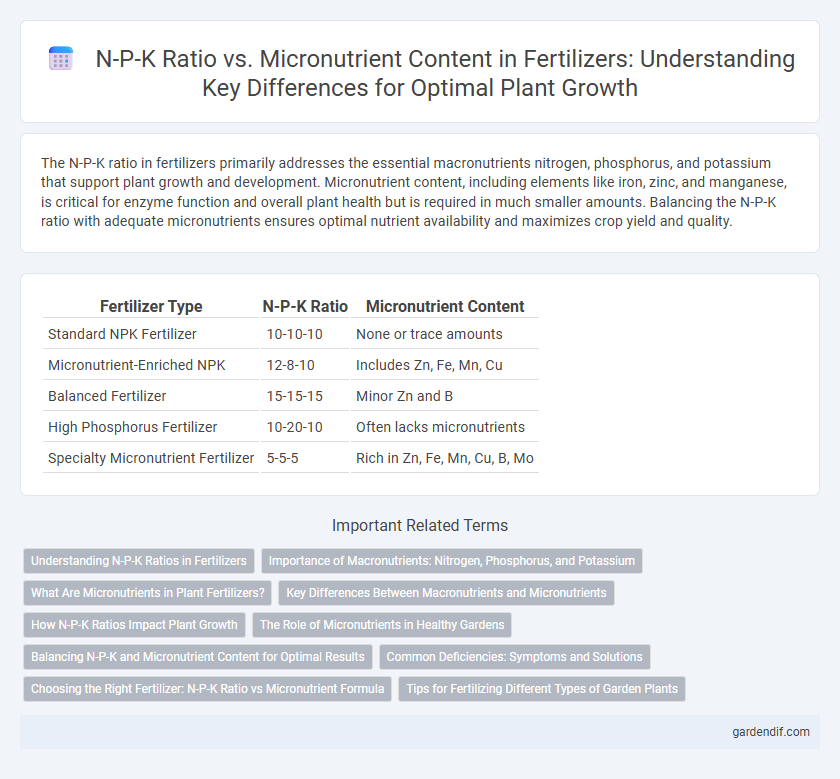
N-P-K ratio vs Micronutrient content Illustration
The N-P-K ratio in fertilizers primarily addresses the essential macronutrients nitrogen, phosphorus, and potassium that support plant growth and development. Micronutrient content, including elements like iron, zinc, and manganese, is critical for enzyme function and overall plant health but is required in much smaller amounts. Balancing the N-P-K ratio with adequate micronutrients ensures optimal nutrient availability and maximizes crop yield and quality.
Table of Comparison
| Fertilizer Type | N-P-K Ratio | Micronutrient Content |
|---|---|---|
| Standard NPK Fertilizer | 10-10-10 | None or trace amounts |
| Micronutrient-Enriched NPK | 12-8-10 | Includes Zn, Fe, Mn, Cu |
| Balanced Fertilizer | 15-15-15 | Minor Zn and B |
| High Phosphorus Fertilizer | 10-20-10 | Often lacks micronutrients |
| Specialty Micronutrient Fertilizer | 5-5-5 | Rich in Zn, Fe, Mn, Cu, B, Mo |
Understanding N-P-K Ratios in Fertilizers
N-P-K ratios in fertilizers represent the percentage by weight of nitrogen (N), phosphorus (P), and potassium (K), essential macronutrients that directly influence plant growth, root development, and overall crop yield. While N-P-K ratios address primary nutrient needs, micronutrient content, including elements like iron, zinc, and manganese, supports enzymatic functions and improves nutrient uptake efficiency. Understanding the balance between N-P-K ratios and micronutrient availability is critical for optimizing fertilizer formulations tailored to specific soil deficiencies and crop requirements.
Importance of Macronutrients: Nitrogen, Phosphorus, and Potassium
Nitrogen, phosphorus, and potassium are essential macronutrients that form the primary N-P-K ratio in fertilizers, directly influencing plant growth, root development, and fruit quality. Nitrogen boosts leaf and stem growth, phosphorus supports energy transfer and root strength, while potassium enhances water regulation and disease resistance. Balancing these macronutrients ensures optimal nutrient uptake, maximizing crop yield and soil health before considering micronutrient supplementation.
What Are Micronutrients in Plant Fertilizers?
Micronutrients in plant fertilizers include essential elements like iron (Fe), manganese (Mn), zinc (Zn), copper (Cu), boron (B), molybdenum (Mo), and chlorine (Cl), which are required in trace amounts for optimal plant growth. Unlike the primary macronutrients nitrogen (N), phosphorus (P), and potassium (K) indicated by the N-P-K ratio, micronutrients support vital physiological functions such as enzyme activation, chlorophyll synthesis, and disease resistance. Balanced micronutrient content in fertilizers enhances nutrient uptake efficiency and improves crop yield and quality.
Key Differences Between Macronutrients and Micronutrients
The N-P-K ratio represents the primary macronutrients--nitrogen, phosphorus, and potassium--essential for plant growth and development in large quantities, whereas micronutrients like iron, manganese, and zinc are required in trace amounts. Macronutrients drive fundamental physiological processes such as photosynthesis and energy transfer, while micronutrients serve as cofactors for enzymatic reactions and maintain overall plant health. The precise balance of N-P-K and micronutrient content in fertilizers ensures optimized nutrient availability, promoting robust crop yield and quality.
How N-P-K Ratios Impact Plant Growth
N-P-K ratios directly influence essential macronutrient availability, with nitrogen promoting leaf and stem growth, phosphorus supporting root development and flowering, and potassium enhancing overall plant health and stress resistance. Proper balance of N-P-K ensures optimal photosynthesis, nutrient uptake, and energy transfer within plants, crucial for maximizing yield. While micronutrients like iron, zinc, and manganese are vital for enzymatic functions, their impact depends significantly on the foundational macronutrient balance established by the N-P-K ratio.
The Role of Micronutrients in Healthy Gardens
Micronutrients such as iron, zinc, and manganese play a crucial role in enhancing plant metabolism and disease resistance, often complementing the primary macronutrients nitrogen, phosphorus, and potassium (N-P-K) for balanced plant nutrition. While the N-P-K ratio dictates fundamental growth stages like root development and flowering, micronutrients support enzymatic functions and chlorophyll synthesis essential for vibrant, healthy gardens. Ensuring a proper balance between N-P-K ratios and adequate micronutrient availability leads to improved soil fertility and robust plant health, optimizing garden productivity.
Balancing N-P-K and Micronutrient Content for Optimal Results
Balancing N-P-K ratios with essential micronutrient content is critical for fertilizer effectiveness, as macronutrients like nitrogen, phosphorus, and potassium support primary plant growth while micronutrients such as iron, zinc, and manganese promote enzymatic functions and chlorophyll synthesis. Ensuring precise fertilizer formulations that address both N-P-K levels and micronutrient availability enhances nutrient uptake efficiency, improves crop yield, and prevents deficiencies that can limit plant development. Soil testing and tailored nutrient management strategies optimize the synergy between macronutrients and micronutrients, leading to sustainable and productive agricultural outcomes.
Common Deficiencies: Symptoms and Solutions
N-P-K ratios in fertilizers primarily address macronutrient needs--nitrogen (N) for leaf growth, phosphorus (P) for root development, and potassium (K) for overall plant health--yet many crops also require micronutrients like iron, manganese, zinc, and copper, which are crucial for enzymatic functions and chlorophyll synthesis. Common deficiencies manifest as chlorosis, stunted growth, or leaf necrosis, each linked to specific micronutrient shortages; for example, iron deficiency causes interveinal chlorosis, while zinc deficiency results in reduced leaf size and malformation. Corrective measures include soil testing to identify imbalances, applying chelated micronutrient amendments, and selecting balanced fertilizers rich in secondary nutrients and trace elements to ensure comprehensive plant nutrition.
Choosing the Right Fertilizer: N-P-K Ratio vs Micronutrient Formula
Selecting the right fertilizer involves balancing the N-P-K ratio with essential micronutrient content to meet specific crop requirements and soil deficiencies. While N-P-K ratios provide the primary macronutrients nitrogen, phosphorus, and potassium crucial for growth, micronutrients like iron, zinc, manganese, and copper support enzymatic functions and overall plant health. Tailoring fertilizer choices based on soil testing and crop nutrient demands optimizes yield, quality, and sustainability in agricultural practices.
Tips for Fertilizing Different Types of Garden Plants
Choosing the correct N-P-K ratio tailored to specific garden plants ensures optimal nutrient availability, promoting balanced growth and flowering. Incorporating micronutrient content such as iron, zinc, and manganese addresses subtle nutritional deficiencies, enhancing plant health and resilience. For leafy vegetables, higher nitrogen supports foliage development, whereas flowering plants benefit from increased phosphorus combined with essential micronutrients to improve bloom quality.
N-P-K ratio vs Micronutrient content Infographic

 gardendif.com
gardendif.com